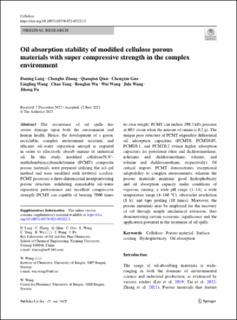| dc.description.abstract | The occurrence of oil spills has severe damage upon both the environment and human health. Hence, the development of a green, recyclable, complex environment resistant, and efficient oil–water separation aerogel is required in order to effectively absorb marine or industrial oil. In this study, modified cellulose/N,N'-methylenebisacrylamide/tannin (PCMT) composite porous materials were prepared utilizing the sol–gel method and were modified with tertbutyl acrylate. PCMT possesses a three-dimensional interpenetrating porous structure, exhibiting remarkable oil–water separation performance and excellent compressive strength (PCMT can capable of bearing 7000 times its own weight; PCMT can endure 290.3 kPa pressure at 80% strain when the amount of tannin is 0.2 g). The unique pore structure of PCMT engenders differential oil adsorption capacities (PCMT0, PCMT0.05, PCMT0.1, and PCMT0.2 evince higher adsorption capacities for petroleum ether and dichloromethane, n-hexane and dichloromethane, toluene, and toluene and dichloromethane, respectively). Of critical import, PCMT demonstrates exceptional adaptability to complex environments, wherein the porous materials maintain good hydrophobicity and oil absorption capacity under conditions of vigorous stirring, a wide pH range (1–14), a wide temperature range (4–160 °C), ultraviolet irradiation (8 h), and tape peeling (10 times). Moreover, the porous materials may be employed for the recovery of oil through simple mechanical extrusion, thus demonstrating certain economic significance and the application potential in the treatment of oil spills. | en_US |

